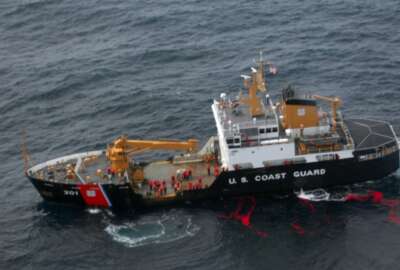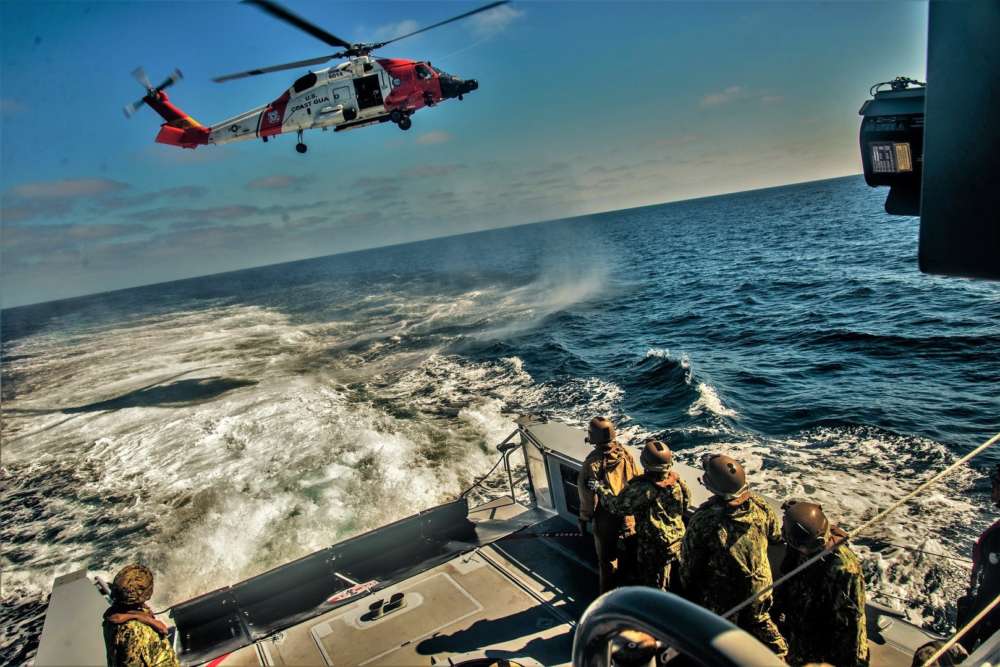

Recruiting challenges for the Army and Air Force mean they have trouble meeting end-strength goals. But what about the Coast Guard? It has also been having trouble...
Best listening experience is on Chrome, Firefox or Safari. Subscribe to Federal Drive’s daily audio interviews on Apple Podcasts or PodcastOne.
Recruiting challenges for the Army and Air Force mean they have trouble meeting end-strength goals. But what about the Coast Guard? It has also been having trouble meeting yearly goals. To find out how the Coast Guard is responding, the Federal Drive with Tom Temin checked in the Commander of the Coast Guard Recruiting Command, Capt. Richter Tipton.
Interview transcript:
Tom Temin: When we last spoke, we discussed the changing tattoo policy for the Coast Guard, partly as a way to just widen the aperture of people that could come into the Coast Guard, give us the current situation 21, 22, what you’re looking at for 23 in terms of required numbers and what you’re able to get into the Coast Guard.
Capt. Richter Tipton: So the Coast Guard is looking for 4,200 new members every year. And that is up from previous years, but mostly because we’ve been recruiting smaller numbers than anticipated for the last four years. So our new number is 4,200. And just last year, we came in just about 2,800 for numbers. So it came in a little short. And what we’re doing is we’re changing the way that we do business a little bit, increasing the aperture again, we reset the age from 36, up to about 42. And we’ve also done some other things on the admission side, that helps us but we’re also looking at changing the way that we do our forward recruiting. So we’ve enlisted the help from our workforce, 47,000 people in the Coast Guard. And we’ve asked them to help us go out and look for glassy eyed people out there in the world who are hustling that would make great Coast Guard officers or great Coast Guard enlisted folks and send them our way. So we’re doing that now.
Tom Temin: So someone can enroll in the Coast Guard up to the age of 42, now, so that’s a lot older than you can the other armed services, correct.
Capt. Richter Tipton: I can’t speak for the other services. But we’re raising ours not to exceed your 42nd birthday on your date of enlistment.
Tom Temin: And when you enlist at the age of 42, what happens? Do you have the same regime of basic training, etc. as someone joining at 19?
Capt. Richter Tipton: Absolutely, it is exactly the same. No standards were changed as far as physical fitness or length of course, or any of that. So anybody who is eligible to enlist goes through our recruiting office, then they go through the MEPS process, which is our medical process, they get their background check as per usual, eight weeks in Cape May select an a school, which is like an MOS for the other services. It’s our trade school, go get a trade and then join the fleet.
Tom Temin: Sure. And have you had many people 37, 8, 9 40, 41, 42 join? Do you know yet?
Capt. Richter Tipton: No, not yet. The policy is relatively new. So we haven’t seen anybody come through at that age. The age is not necessarily the issue for us. Really what we’re concerned with is can they make it through the rigors of bootcamp. So it’ll be interesting to see if older folks can make it through those rigors.
Tom Temin: Yeah, because well, they say 42 is the new 32, 52 is the new 42. You keep hearing this from time to time. I mean, I ran my first marathon at 45. So maybe I could have done it. But it’s also a matter of mindset, because you’re getting people that have been working for possibly 20 years somewhere else, versus people that have never really worked professionally. They might be just out of college or even just out of high school.
Capt. Richter Tipton: That’s absolutely true. Let’s say you are a trade skilled person out in the field. So let’s say for example, you spent 20 years cooking, we actually have what we’re calling a Lateral Entry Program, which is if your skill set matches the skill set that we would teach you at our A school that we can bring you in as a mid grade petty officer. And so what will you do in that case is we would put together what we call a rate determination package is basically a resume, take it to a reining force master chief, who is the person who runs each rate, see what level would match the school system that we have. And then if you’re a great fit, then we’ll walk you right into the E4, E5, E6 level.
Tom Temin: Right. And that’s really a great appeal. And how do you get the word out to people beyond the normal recruiting mechanisms so that people that have got those trade skills and are in good health and want to big switch know about it?
Capt. Richter Tipton: Oh, sure. Well, Tom, this is one of the ways is interviewing with you. But we’re also doing a massive push in our social media campaigns. We have targeted advertisements that we’re developing for older folks who may have trade skills. This isn’t our first time recruiting this population. We also have a reserve program, which relies heavily on trained craftsmen. And so we already do a little bit of this lateral entry on the reserve side. This is mostly modifying it for the active duty side.
Tom Temin: We’re speaking with Capt. Richter Tipton. He is commander of the Coast Guard Recruiting Command. And let’s talk about the younger set. Also, you know, the armed services are finding that once you weed out the people that are say, overweight, or can’t meet physical requirements, for some reason, might have a drug conviction history, et cetera, et cetera, of the population that was traditionally drafted or is now a recruitment age is much smaller than the actual population of people out there at that age. So you must find that same issue. What are some strategies to get the interest level up, so at least you can attract a higher percentage.
Capt. Richter Tipton: As with the other services we get together, every now and again, most recently was in September with the other commanding officers of the recruiting services. We basically have seen the exact same situation just like you described is a changing demographic. Kids today spend more time in computers less time outside, so they’re likely to be less physically fit, which is something that we can address up front through a pre-training system, the Army has one that we’re watching very closely where they send kids to a basically a pre-boot camp to get them kind of like a couch to 5K kind of system. Also, we do see a lot of medical conditions being prescribed early. And you can see things like ADHD medications, and we have waivers for some of those depending on the circumstances. You also see cultural shifts, like you were talking about with body tattoos we were talking earlier, also some drug use and things and we have ways to work those situations depending on the context. And what you’ll hear mostly, I think from other services is a desire to serve propensity to serve that sort of thing. We’re looking at that as a, you just don’t know you want to serve yet. So I believe that if I can get in front of a group of people, and we can tell them about the Coast Guard, that they’ll want to join our service. So for example, the way that we’ve approached this is, we’d like to follow the Department of Defense, we have the same pay benefits, education benefits, even the same skills training that the Department of Defense has. But we also have primarily domestic deployments, we have an environmental mission, a life saving mission, we do search and rescue as our primary mission. So domestic deployments are pretty important to a lot of folks. And we think if we can get in front of people and tell them that, we can win. And also, I like to add on a little flair on my own side, which is, I never slept in a tent, or eaten a meal out of my helmet or deployed overseas with the Department of Defense unless I wanted to. And I’ve wanted to three times in the Indo-Pacific region, working on Japan, in SOUTHCOM, working out of Haiti, and in Yukon, as the Arctic rep working out of Germany. So we offer those benefits as well. And I wouldn’t trade any of my time with my Department of Defense cousins for a second.
Tom Temin: Sure. I guess somehow that sea rations idea out of the helmet persists 75 years after it actually existed, the food’s actually pretty good, isn’t it?
Capt. Richter Tipton: Listen, I have, I have enjoyed many a ration out of a warm bucket in Haiti. So I can tell you I do like my MREs.
Tom Temin: And how was the Coast Guard responding with the smaller numbers coming in? Is there a concomitant program to retain people that might otherwise muster out and stick around for a couple of years?
Capt. Richter Tipton: We are definitely working to retain folks and even bring them back. Once your activity enlistment is up, you can switch into the reserves or the IRR, the inactive reserve component, we can bring folks back on to active duty from those components. We’re actively looking for that all the time. And this lateral entry program that I talked about before about bringing folks in, they don’t have to be just civilians off the street, they can be prior military from other services as well, we can lateral entry directly into the Coast Guard. So we’ve got programs to keep people who have skills or return people who had skills into the Coast Guard. We’re focused fairly heavily on that, unfortunately, on the recruiting side of things. So that’s a whole different branch. But they’re they’re doing a fantastic job in the retention side.
Tom Temin: Yeah. I mean, they must talk to you about what’s going on just so you have a sense of what you can tell people that might be coming in what they could expect down the line.
Capt. Richter Tipton: Oh, sure, absolutely. And they tell me why people might be leaving so that I can adjust my targeting to make sure that we target folks who would be interested in staying later on because our goal is actually a 20 year career in the Coast Guard is what we want folks to want. But we offer two year enlistments, three year enlistments, four year enlistments. So we, we have a whole slew of things that we offer. But we’re really looking for people who are going to be here, join our family for the long term.
Tom Temin: And do you find that people that may not have been or thought of themselves as suitable, or they don’t pass the initial physical requirements. And you have to kind of bring them as you said, couch to what was the term couch to?
Capt. Richter Tipton: Couch to 5K. It’s a program for folks who want to run a 5K but may have not ever worked out before.
Tom Temin: I see at that age, especially the younger ages, that can really happen pretty quickly, right?
Capt. Richter Tipton: Yes, if you are interested in the Coast Guard, but maybe you weren’t as physically fit as you would like to be. Or maybe you’re not able to do the forming standards that Cape May, we would still work with you bring you in, get you medically qualified and make sure everything’s fine. And then we would put you in what we call caretaking program, which is basically it’s a weekly physical fitness check. And it’s up to you, of course to get yourself into shape. But most offices run every Friday, they run the session standard so it’s a mile and a half and a certain time and then sit ups and push ups and once the office and you are confident that you’ll be able to pass the entry for physical fitness requirements. Then we would put you in, get you a reservation and bring you right into the Coast Guard.
Copyright © 2025 Federal News Network. All rights reserved. This website is not intended for users located within the European Economic Area.
Tom Temin is host of the Federal Drive and has been providing insight on federal technology and management issues for more than 30 years.
Follow @tteminWFED



